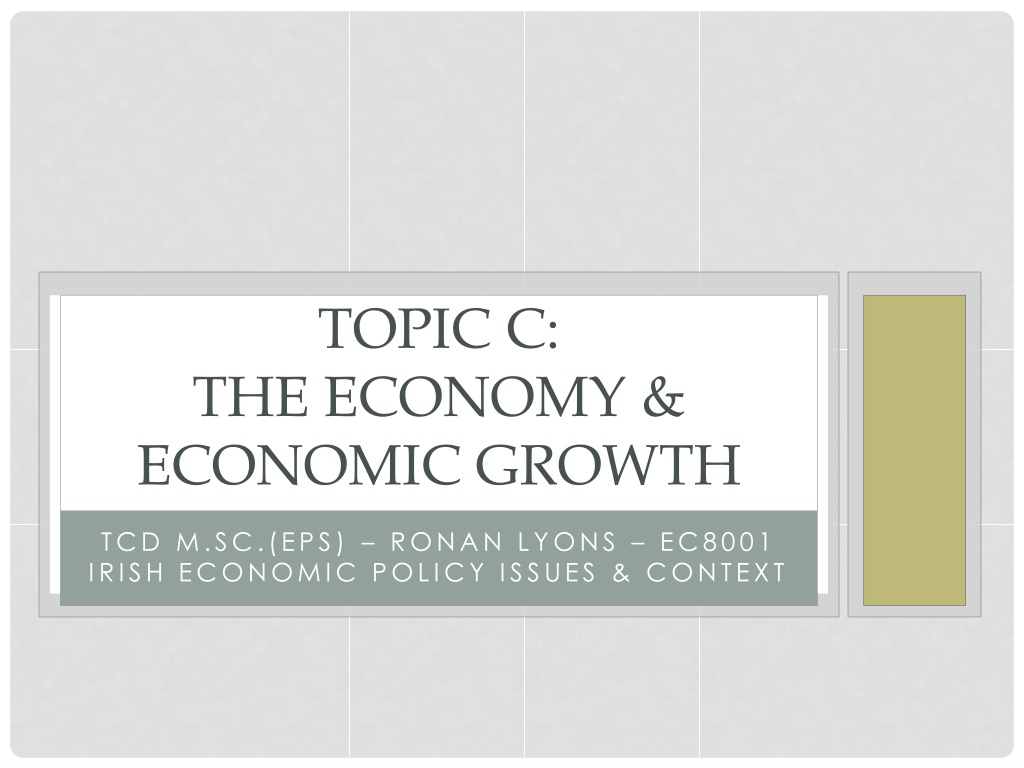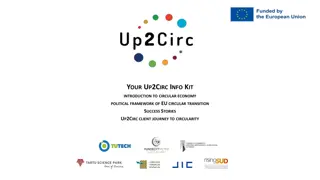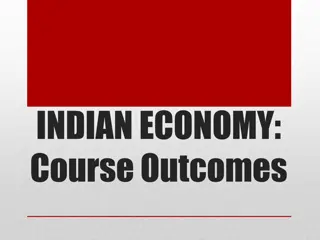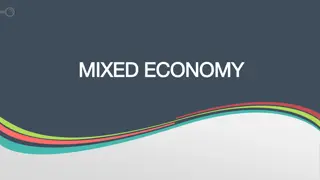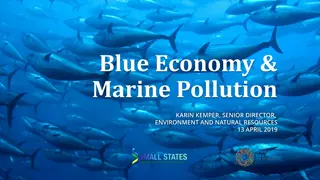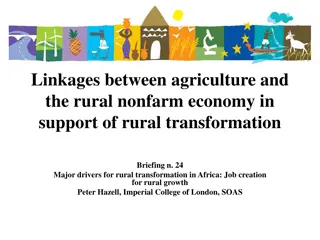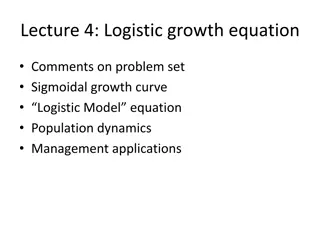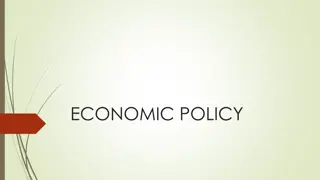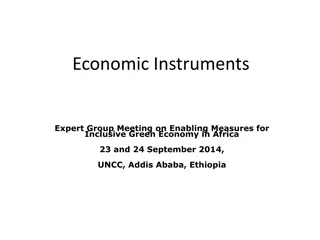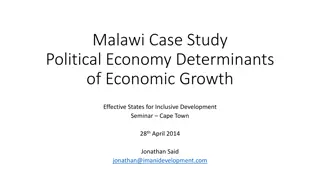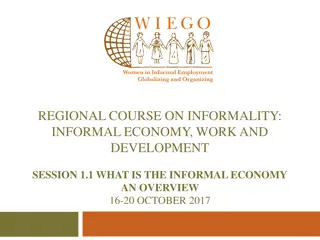TOPIC C: THE ECONOMY & ECONOMIC GROWTH
Delve into the structure, aims, and levels of the Irish economy through topics such as GDP, economic growth, trade policy, and living standards. Explore historical perspectives, modern growth trends, and key policy tools shaping Ireland's economic landscape.
Download Presentation

Please find below an Image/Link to download the presentation.
The content on the website is provided AS IS for your information and personal use only. It may not be sold, licensed, or shared on other websites without obtaining consent from the author.If you encounter any issues during the download, it is possible that the publisher has removed the file from their server.
You are allowed to download the files provided on this website for personal or commercial use, subject to the condition that they are used lawfully. All files are the property of their respective owners.
The content on the website is provided AS IS for your information and personal use only. It may not be sold, licensed, or shared on other websites without obtaining consent from the author.
E N D
Presentation Transcript
TOPIC C: THE ECONOMY & ECONOMIC GROWTH TCD M.SC.(EPS) RONAN LYONS EC8001 IRISH ECONOMIC POLICY ISSUES & CONTEXT
MODULE OUTLINE Topic Title A B C D E F G H I J EoI Ch 1+ 1+ 2, 7 3, 4 6 8 5 9, 11 12, 13 10, 14* Dates MT1-2 MT3-4 MT5-6 MT8-9 MT10-11 HT1-2 HT3-4 HT5-6 HT8-9 HT10-11 Irish Economic History to Independence Irish Economic History since Independence The Economy & Economic Growth Public Finances, Debt & Taxation The Labour Market Social Justice & Inequality Regulation & Competition Competitiveness & Trade Health & Education Natural Resources & Real Estate
TOPIC C: STRUCTURE The Economy & Economic Growth 1. Conceptualizing the economy 2. National income accounts 3. GDP, welfare and public policy 4. Efficiency and production possibilities 5. Modern economic growth 6. Productivity performance
FROM TACTICS TO STRATEGY Three main tools of economic policy were mentioned in Topic B Trade policy ( ) historically tariffs; within EU/WTO, replaced by competitiveness policy Monetary policy (r) concerned with currency, interest rates, money supply; within Eurozone, replaced at national level by macro-prudential policy Fiscal policy (G) decisions about government revenues and spending; limits within EU but increasingly important But these are the tools what are the aims?
AIMS OF A REGIONAL ECONOMY The principal aim of an economy s policymakers is to deliver a high(er) standard of living Most often measured through citizens average income Behavioural issues: relative vs. absolute, momentum Range of ancillary and secondary objectives Full employment will be reflected in higher incomes Competitiveness should be reflected in higher incomes Fair distribution of income may not be reflected Stability reflected in consistently high living standards (also: good/asset price stability) Sustainability as above, but over longer time-frame (may be at odds with higher living standards over short run)
LEVELS OF LIVING STANDARDS GDP per capita ($ PPP), 1921-2010 $60,000 Western Europe $50,000 Ireland $40,000 $30,000 $20,000 $10,000 $0 1920 1965 2010 1925 1930 1935 1940 1945 1950 1955 1960 1970 1975 1980 1985 1990 1995 2000 2005 Source: Maddison Project Database (2013)
GROWTH IN LIVING STANDARDS Average annual growth in GDP per capita, by period 5% 4% Irish 3% catch-up 2% 1% 0% Western Europe Ireland European slow down -1% -2% -3% -4% -5% 1921- 1929 1929- 1939 1939- 1946 1946- 1960 1960- 1973 1973- 1987 1987- 2007 Source: Maddison Project Database (2013)
WORLDS RICHEST COUNTRIES Per capita GDP of richest & poorest countries, 2014 $100,000 $90,000 $80,000 $70,000 $60,000 $50,000 $40,000 $30,000 $20,000 $10,000 $0 Brunei Denmark USA Saudi UAE Switzerland Germany Singapore Norway Bahrain Sweden Luxembourg Hong Kong Canada Oman CAR Kuwait Netherlands Ireland Malawi Burundi Liberia DRC Austria Australia
FEATURES OF THE TOP 20 Luxembourg Singapore Brunei Darussalam Kuwait Norway United Arab Emirates Switzerland Hong Kong SAR United States Saudi Arabia Bahrain Netherlands Ireland Australia Austria Germany Sweden Canada Denmark Oman Size big or small? Location? Island/landlocked? Resources? History? Real #1 is Qatar!
MODEL OF THE ENTIRE ECONOMY How would you go about modelling an entire economy? Not as complicated as it sounds: ultimately, in an economy, there are only sellers and buyers Sellers provide a service Sometimes that service is a physical item, a commodity like copper or merchandise such as TV but even then its value lies in the service it provides Buyers pay money in return
A PRE-INDUSTRIAL ECONOMY No firms, so aside from subsistence production, households trade with each other through markets sell goods Markets Households buy goods
A MODERN ECONOMY 1. Firms sell goods that are bought by households 2. Money flows in the opposite direction Goods markets Firms Households 3. Firms in turn require inputs, owned by households Factor markets Real Monetary
NOTES ON THE CIRCULAR FLOW Two important features about the circular flow model of the economy Every real flow has a corresponding monetary flow Some of these may be imputed, e.g. stay-at-home spouse or owner-occupier s rent Someone s expenditure is someone else s income Adding up income should be equivalent to adding up expenditure In an economy like this, any injection (e.g. new deposit) would circulate around economy forever No leakages annual impact would depend on velocity
DEVELOPING THE CIRCULAR FLOW Three main additions to realism of the circular flow 1. Government taxation, a payment by households to government in return for public goods 2. Banking saving (non-consumption) generates an income (interest); the financial system transforms into lending (saving and investment as opposites) 3. Trade final leakage is spending on imports, offset (at least in part) by income from exports These reduce the final economic impact of any injection into an economy
TOPIC C: STRUCTURE The Economy & Economic Growth 1. Conceptualizing the economy 2. National income accounts 3. GDP, welfare and public policy 4. Efficiency and production possibilities 5. Modern economic growth 6. Productivity performance
GROSS DOMESTIC PRODUCT (GDP) Helps compare apples and oranges everything expressed in euro GDP is the market value of all final goods and services produced within a country in a given period of time Everything sold (previously just legally) in the economy To avoid double-counting, leaves out intermediate goods (e.g. paper supplies for greeting card company) Only new goods counted e.g. not 2nd-hand cars/homes In Ireland s case, only what s produced here, i.e. doesn t include any output by a French company part-owned by an Irish household Usually a year but people also pay attention to quarterly figures
OUTPUT VERSUS INCOME GDP is the value of all goods & services produced within a country in a given period of time GNP is the value of all income earned by a nation s residents, regardless of where it was earned Only GNP will include the profits earned through Irish firms overseas plants, e.g. CRH or Ryanair. Only GDP will include the profits of multinationals based here, such as Google or Pfizer Both GDP and GNP for Ireland will include output by firms owned by Irish residents and which operate in Ireland (including their exports).
FOUR METHODS, SAME ANSWER? Possible to calculate economy s size (i.e. the sum of all activity) in any one of three [four] ways 1. Expenditure method add up all money spent on final goods and services 2. Income method add up all money earned through all sources (wages, rents, profits) 3. Output method add up value of all goods and services produced 4. Consumption method add up value of all goods and services consumed [not aware of any attempts at this] To understand why, go back to circular flow In practice, answers across methods vary
COMPONENTS OF GDP AND GNP GDP = Y = C + I + G + NX GNP includes net factor income Y = C + I + G + NX +NFI GVA = GDP - taxes/subsidies GNI = GNP + EU transfers
COMPONENTS OF GDP IN IRELAND Quarterly GDP (2011 prices), by component 45,000 40,000 35,000 Millions of euro 30,000 Net Exports Government Investment Consumption 25,000 20,000 15,000 10,000 5,000 0 1998q3 2003q3 2008q3 2013q3 Source: CSO National Accounts
TRENDS IN IRISH OUTPUT & INCOME Irish GDP & GNP ( bn) GNP as % of GDP 200 90% GDP GNP 180 88% 160 140 86% 120 84% 100 82% 80 60 80% Interpretation? 40 78% 20 76% 0 2007 1995 1997 1999 2001 2003 2005 2009 2011 2013 1995 1997 1999 2001 2003 2005 2007 2009 2011 2013 Source: CSO National Accounts
DECOMPOSING GROWTH Mathematically, growth in per capita incomes comprises five factors Productivity (GNP/hour) Effort (hours/worker) Employment (worker/ labour force) Partipication (labour force/15-64 population) Demography (15-64 population/full pop n) GNP per capita growth 10% Demography Participation Employment Effort Productivity 8% 6% 4% 2% 0% -2% -4% -6% 1994- 2000 2000- 2007 2007- 2013
JOBLESS GROWTH, GROWTHLESS JOBS In addition to real GDP, key Irish policy metrics in include growth in GNP and employment Economic contraction from mid-2008 to mid- 2010 Decline in jobs until mid- 2012 2013: growth in jobs while GDP stagnated GDP s patent cliff vs. GNP s new citizens Annual change in quantities 15% GDP GNP Jobs 10% 5% 0% 2006Q1 2006Q4 2007Q3 2008Q2 2009Q1 2009Q4 2010Q3 2011Q2 2012Q1 2012Q4 2013Q3 2014Q2 -5% -10% -15%
TOPIC C: STRUCTURE The Economy & Economic Growth 1. Conceptualizing the economy 2. National income accounts 3. GDP, welfare and public policy 4. Efficiency and production possibilities 5. Modern economic growth 6. Productivity performance
WHATS IN GDP? When measured well, GDP includes the value of amenities GDP was recently updated to include value added from illegal activities To my knowledge, value added by house- spouses not yet included Is Ireland better off neighbours start minding each other s children for 200 a week? Imputed rent, as % of national income 6.0% 5.0% 4.0% 3.0% 2.0% 1.0% 0.0% 1995 1997 1999 2001 2003 2005 2007 2009 2011 2013 Source: CSO National Accounts
GDPS LIMITS: OTHER GOODS Black market: From 2014 on, meant to include illegal activities How accurate will this be? Non-market goods: The best things in life are free value of leisure time excluded But note that parks and other amenities captured in (imputed) rents are included Source: Irish Examiner
GDPS LIMITS: DISTRIBUTION GDP per capita is a mean (i.e. an average) A single summary measure of a level GDP says nothing about spread around mean First moment vs. second moment Where incomes are similar, extra measures desirable Gini, %ile ratios (e.g. 90/10) 90/10 OECD average: 4.3 More in Topic F 90/10 income ratio Australia Austria Belgium Canada Chile Czech Denmark Estonia Finland France Germany Greece Hungary Iceland Ireland Israel Italy Japan Korea Lux Mexico NL NZ Norway Poland Portugal Slovak Slovenia Spain Sweden Switz Turkey UK USA 0 1 2 3 4 5 6 7 8 9 10
GDPS LIMITS: BADS Bads are activities that contribute to GDP but are (to some extent) unwelcome, e.g. production that pollutes
GDPS LIMITS: PERVERSE GOODS Japanese earthquake 2011 Activities that are welcome but are due to things that are not welcome, e.g. post- war construction How much does Australia spend on forest fires compared to, say, Iceland? This matters for policy US- EU comparisons don t include effect of climate on GDP ~5% of homes in Europe have AC, compared to 83% of US homes Japan has said it will cost $309bn to rebuild the country after the deadly earthquake and tsunami According to the World Bank, Japan will need up to five years to rebuild.
SHOULD WE MEASURE HAPPINESS? Ireland is happy! Ireland is unhappy! Irish Times, Dec 23 2011 Irish Times, Jan 4 2012 "The EU Survey on Income and Living Conditions showed 79 per cent of the Irish population aged 18 and over reported themselves in 2010 to have been happy all or most of the time over the four weeks prior to the interview." The Irish are among the unhappiest of 58 nationalities, according to a poll by WIN- Gallup International of net happiness , or the percentage of people who considered themselves happy, minus the percentage who considered themselves unhappy." Happiness seems to be adaptive : people learn to cope with their circumstances but does that mean we should leave people in poverty?
LESSONS FROM BHUTAN & OBAMA Happiness is outcomes minus expectations High happiness could be good outcomes or low expectations Or due to human quirks Gallup: huge jump in national well-being in US shortly after Obama took office Compromises, e.g. UN HDI Source: Financial Times
TOPIC C: STRUCTURE The Economy & Economic Growth 1. Conceptualizing the economy 2. National income accounts 3. GDP, welfare and public policy 4. Efficiency and production possibilities 5. Modern economic growth 6. Productivity performance
FROM EXPENDITURE TO OUTPUT So far, thinking about GDP as the sum of all expenditure C, I, G, NX Remember that GDP is also the sum of all income, in wages, profits, rents, etc. GDP is the flow accruing to factors of production Stocks vs. flows Three main factors of production L: Labour, or human capital N: Land, or natural capital K: Physical & financial capital formed by investment The relationship between inputs and outputs is technology , A
THE PRODUCTION FUNCTION Output depends on: Capital (100 units) Labour (1 100 workers) Technology 120 K=100, =2/3 100 80 Output 60 Y = f (A, K, L, N) Here, leaving aside N 40 20 A = 1 0 0 20 40 60 80 100 Input (Labour) Production function, Y=AK1- L (1) Diminishing marginal product (2) Constant returns to scale
DMR & CRTS For a fixed stock of capital (and land), adding more workers will lower their incomes The getting in the way effect But if K, L and N are doubled, what happens output? Constant RTS Or increasing or decreasing RTS?
PRODUCTION POSSIBILITIES FRONTIER Suppose there are 2 goods in the economy: bagels ( =0.8) & iPads ( =0.4) What does mean? Both have K=100 (e.g. factory dedicated to that good can t make other good) A (technology) is the same for both We can allocate our 100 workers any way we want -> A curve showing all possible combinations of production 120 100 80 iPads 60 40 20 0 0 20 40 60 80 100 120 Bagels Production possibilities frontier
PPF & TECHNOLOGY An improvement in technology ( A from 1 to 1.1) expands economic possibilities Can consume more of both Important distinction between Reducing inefficiency (X Z) Reallocating resources (Y Z) Economic growth (this graph compared to last one) 120 100 Y 80 Z iPads 60 X 40 20 0 0 20 40 60 80 100 120 Bagels Production possibilities frontier
PPF & TRADE In a one-economy model, the PPF contains insights about (in)efficiency and full employment It does not say anything about whether it is preferable to produce more bagels or more iPads About technology (supply) not preferences (demand) Adding a second country, with a different technology, still tells us nothing about consumption But it does reveal insights about who should produce what Comparative advantage and opportunity cost More on this in Topic H International trade and competitiveness
TOPIC C: STRUCTURE The Economy & Economic Growth 1. Conceptualizing the economy 2. National income accounts 3. GDP, welfare and public policy 4. Efficiency and production possibilities 5. Modern economic growth 6. Productivity performance
PRE-MODERN ECONOMIC GROWTH Malthusian Thomas_Malthus.jpg Any technological improvement goes to higher populations not higher incomes Without sufficient food (i.e. without technology/ productivity) a larger population is self- correcting (war, famine) As per Hobbes, the life of man [is] solitary, poor, nasty, brutish & short Thomas Robert Malthus, 1766-1834
SWITCHING GROWTH ON? How did the trend level of growth in average incomes go from 0% to 2-3%? Technological progress in the cotton industry first is at the heart of the first escape from the Malthusian Trap Britain in the late 1700s and early 1800s cf. Topic A Modern economic growth has spread to most parts of the world in the last two centuries What does this tell us about how less developed countries today can embark on economic growth? Need a conceptual framework and theory of economic growth
PRODUCTION FUNCTIONS AGAIN Output depends on: Capital (100 units) Labour (1 100 workers) Technology For given stocks of capital and labour, economic growth = A (improvement in technology) 120 K=100, =2/3 100 80 Output 60 40 A = 1 20 0 0 20 40 60 80 100 Input (Labour) Production function, Y=AK1- L
AGGREGATE VS. PER CAPITA Aggregate GDP Y = f (A, K, L, N) An increase in L leads to an increase GDP (US vs. Ireland) Per capita GDP Y/L = f (A, K, N) With N fixed, growth in per capita output comes from A, K Hence the focus on Attracting capital Technological progress Remember that A = broad technology E.g. reducing inefficient processes increases A
EXOGENOUS GROWTH MODELS Roots in 1950s (Robert Solow, MIT) Based on production function Diminishing returns means growth can t come from physical capital Adding extra capital to fixed stock of labour is just like the reverse (Burdock s example) Per-capita incomes: growth can t come from labour either Assuming constant returns to scale Growth instead comes from technological progress, which is simply assumed Not a very satisfying view of the world!
ENDOGENOUS GROWTH MODELS Popular in/since 1990s (Paul Romer, Stanford) Aim: where do technological progress come from? Together with fluctuations (boom/bust cycles), understanding trend growth rates a key concern of macroeconomics A number of strands of endogenous growth model One strand abandons diminishing returns to accumulating capital Another tries to explain technological progress; new ideas rewarded -> innovation A third focuses on human capital (skills): as important as physical capital
CAN GROWTH CONTINUE FOREVER? Scale of growth matters 0.2% vs. 0.8% vs. 2% vs 3% 50,000 vs. 750,000 in 100 years time Note also imprecision with which GDP is measured Type of goods consumed matters also Services now 75-80% of developed economies What is resource footprint of service (vs. good)? Is it possible to improve things 1% a year? Per capita income ( ) in 2115, different growth rates 900,000 800,000 700,000 600,000 500,000 400,000 300,000 200,000 100,000 0 Now 0.20% 0.80% 2% 3%
TOPIC C: STRUCTURE The Economy & Economic Growth 1. Conceptualizing the economy 2. National income accounts 3. GDP, welfare and public policy 4. Efficiency and production possibilities 5. Modern economic growth 6. Productivity performance
LABOURS MARGINAL PRODUCT Ultimately, per capita incomes depend on the value of output a worker produces Economics often assumes that wages reflect the marginal product of labour An increase in MPL could come about due to changes in the price of what they produce The difficulty with measuring productivity in domestically traded and public services Balassa-Samuelson effect : the economics of hairdressers wages Strictly, though, productivity is about the quantity of output (of a fixed quality) produced in, say, 1 hour
